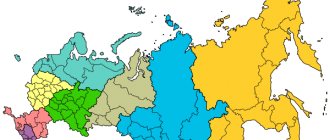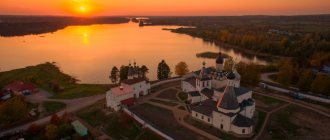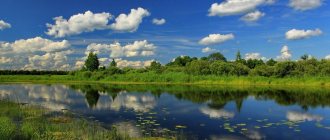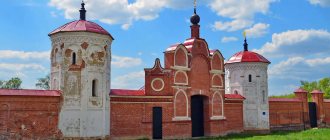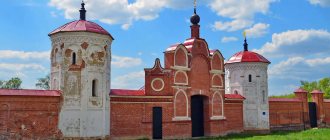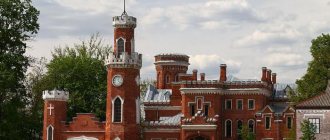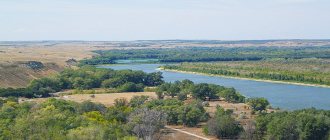Belgorod region
(unofficial
Belogorye, Svyatoe Belogorye, Belgorodchina, Belgorodshchina
) is a subject of the Russian Federation, located in the southwestern part of Russia, 500-700 km south of Moscow, on the border with Ukraine. The largest cities: Belgorod - 394,142 people, Stary Oskol - 223,921 people, Gubkin - 86,229 people.
The Belgorod region was formed on January 6, 1954. From that moment on, its borders did not change.
Regional center
- Belgorod.
Physiographic characteristics
Geographical position
The Belgorod region is part of the Central Black Earth economic region and the Central Federal District of the Russian Federation. In the south and west it borders with the Lugansk, Kharkov and Sumy regions of Ukraine, in the north and northwest - with the Kursk region, in the east - with the Voronezh region. The total length of its borders is about 1,150 km, of which 540 km are with Ukraine.
The area of the region is 27.1 thousand km², the length from north to south is about 190 km, from west to east – about 270 km.
Climate
The climate is temperate, temperate continental, with fairly mild winters with snowfalls and thaws and long summers. The average annual air temperature varies from +5.4 degrees in the north to +6.8 degrees in the southeast. The coldest month is January. The eastern and south-eastern regions of the region are crossed, at their average value, by the Voeikov axis, which has a certain influence on the climate, especially in these areas. The frost-free period is 155-160 days, the duration of solar time is 1800 hours.
Minerals
More than 40 percent of the country's proven iron ore reserves are concentrated in the region. The deposits belong to the Kursk magnetic anomaly.
Large deposits of bauxite, apatite, mineral groundwater (radon and medicinal table water), and numerous deposits of building materials (chalk, sand, clay, etc.) have been identified and explored to varying degrees. Demonstrations of gold, graphite and rare metals are known. There are geographic prerequisites for identifying platinum, hydrocarbons and other minerals.
Hydrography
The territory of the Belgorod region belongs to the basins of two seas: the Black (western part of the region) and the Azov (central and eastern part of the region).
The region is classified as low-water. This is due not only to the amount of precipitation, but also to the topography of the area.
About 1% of its territory is occupied by rivers, lakes, and swamps. More than 480 small rivers and streams flow here. The largest of them in the north-west are Seversky Donets, Vorskla, Vorsklitsa, Psyol, in the eastern regions - Oskol, Tikhaya Sosna, Chernaya Kalitva, Valuy. The total length of the river network is 5000 km.
There are 1,100 ponds and 4 reservoirs in the region.
Animal world
The fauna of the Belgorod region is meadow-steppe. The calcophilous zoocomplexes associated with the Cretaceous deposits give the fauna a special uniqueness. The fauna of the Belgorod region contains, according to various estimates, from 10 to 15 thousand species. The mammal fauna of the Belgorod region includes 68 species from 6 orders and 18 families, including 25 species from the order Rodents, 14 species from the order Carnivora, 10 species from the order Chiroptera, 9 species from the order Insectivorous, 7 species from the order Artiodactyla, 2 species from the order lagomorphs. There are about 279 species of birds, including 152 nesting, the rest migratory and migratory.
About 10% of animal species are considered to be in need of special protection; 269 species are included in the Red Data Book of the Belgorod Region.
Vegetation
The vegetation cover of the region reflects the features of the northern forest-steppe, which is characterized by alternating forests with meadow steppe.
It is represented by two types of vegetation: zonal and extrazonal. Zonal vegetation is upland oak forests (221 species) and steppe meadows (211 species). Extrazonal vegetation includes meadows (232 species), species of shrubs and forest edges (161 species), phytocenoses of chalk outcrops (93 species) and synanthropic communities (192 species). In general, the flora of the region includes 1284 species. The forest cover of the region is 8.6%. More than 800 hectares of forests are classified as specially protected areas due to the growth there of rare plant species and animal habitats, which are included in the Red Book.
Following the results of the all-Russian event of the Ministry of Natural Resources and Ecology of the Russian Federation “Alley of Russia” in 2014, the feather feather grass became the symbol of the Belgorod region.
Soil cover
Zonal soils are represented by chernozems (77% of the territory) and gray forest soils (almost 15% of the territory).
The type of chernozems is represented in the region by the subtypes of podzolized, leached, typical and ordinary chernozems. The first three subtypes are characteristic of the forest-steppe part of the region.
The type of gray forest soils is represented in the region by the subtypes of dark gray forest and light gray forest. Unlike chernozems, gray forest soils in the Belgorod region are distributed unevenly, but in the form of 5 large tracts confined to places where large forests are concentrated and their surroundings.
Demography
Smolensk Church in Belgorod
In terms of area, the region ranks 67th among the subjects of the Russian Federation; and in terms of population it is 28th (according to the results of the 2010 Census, [7] the results obtained are two places higher compared to the 2002 Census. According to the results of the 2010 Census, the population of the region was 1,532,526 people, of which 66, 1% urban population, 33.9% rural population.[7] This is compared to 1,511,620 recorded in the 2002 Census[12] and 1,380,723 counted in the 1989 Census.[13]
The population density in 2008 was 56.1 people per 1 km2.[14] The average age is 38.5 years - 35.6 years for men and 41 years for women; 46% of the population are economically active.
As in other regions of the European part of Russia, since the collapse of the Soviet Union there has been a natural population decline (about -5 per 1,000 population). There has been some reversal of this decline in recent years as a result of rising birth and death rates. However, despite the negative growth trend, the region's population remains relatively stable due to immigration. Belgorod attracted pensioners from the Far North and Ukraine back in Soviet times. This trend has accelerated since 2005 and is now offsetting natural population decline. Migrant workers also arrive in Belgorod from Uzbekistan; although, unlike Ukrainian immigrants, Muslim migrants face daily discrimination and decide to leave.[15]
Old Russian towel in Belgorod
Story
Monuments of the Saltovo-Mayatsk culture (Yutanovskoye settlement) date back to the 8th century in the Belgorod region. Since the 8th century, the west of the Belgorod region has been developed by northerners (Romensk-Borshchev culture). In the 8th-9th centuries this territory came under the rule of the Khazaria. During the years of Kievan Rus, it was part of the Chernigov principality. The Mongol-Tatar invasion led to the desolation of the region. Then the Grand Duchy of Lithuania began to develop the Belgorod region. Since 1500 it has been part of the Grand Duchy of Moscow.
At the turn of the 16th-17th centuries, for the reliable protection of Russian possessions, a continuous line of military fortifications was built - the Belgorod defensive line, which stretched for almost 800 kilometers. Belgorod became a military-administrative center, in which the Great Belgorod Regiment was stationed. In the 16th century, on the territory of the Belgorod region, on the banks of the Oskol River, there was a fortress, which later turned into the Valuysky Orthodox monastery. Having emerged as an outpost on the southern borders of Russia, the Belgorod region wrote many wonderful heroic pages into its history. For their exploits in the battle of Poltava, Peter I granted a banner to the soldiers of the Great Belgorod Regiment.
In 1708-1727, the territory of the modern Belgorod region was part of the Kyiv and Azov provinces. In 1727, the Belgorod province was formed, which existed until 1779. It occupied the lands not only of the modern Belgorod region, but also the territories of the modern Kursk, Oryol, partially Bryansk and Kharkov regions. The province had its own coat of arms, which is now the coat of arms of the Belgorod region.
In 1775-1779, the territory of the Belgorod province was divided between the newly formed provinces and governorships, and the province itself was abolished. The Belgorod region, including the city of Belgorod, became part of the Kursk governorate; the southeastern districts were assigned to the Voronezh province, the southern ones - to the Sloboda province. In the 19th century, Belgorod land was part of the Kursk province.
After the signing of the Brest Peace, from April 1918 to January 1919, the Belgorod region was an integral part of the Ukrainian state of Hetman P. P. Skoropadsky.
Until 1928, the territory of the modern Belgorod region was part of the Voronezh and Kursk provinces. In the 1930s, collectivization took place in the Belgorod region; in this decade, 40 thousand residents were repressed, of which 15 thousand were shot.
During the Great Patriotic War, the famous Prokhorov tank battle took place on Belgorod soil, which became the starting point of the Victory over Nazi Germany. In memory of him, 40 km from the southern face of the Arc of Fire, on the third military field of Russia, Prokhorovsky, a Victory Monument was erected - the Belfry, and in the village itself, the Church of the Holy Apostles Peter and Paul was built using public donations. These and a number of other objects are united into the State Military Historical Museum-Reserve "Prokhorovskoye Field"
On January 6, 1954, the Presidium of the Supreme Soviet of the USSR issued a decree on the formation of the Belgorod region. The region included: from the Kursk region - the cities of Belgorod and Stary Oskol, Belgorodsky, Belenikhinsky, Bobrovo-Dvorsky, Bolshe-Troitsky, Borisovsky, Valuysky, Velikomikhailovsky, Volokonovsky, Grayvoronsky, Ivnyansky, Korochansky, Krasnoyaruzhsky, Mikoyanovsky, Novo-Oskolsky, Prokhorovsky, Rakityansky, Sazhensky, Skorodnyansky, Staro-Oskolsky, Tomarovsky, Urazovsky, Chernyansky and Shebekinsky districts; from the Voronezh region - Alekseevsky, Budenovsky, Veidelevsky, Ladomirovsky, Nikitovsky, Rovensky, Ukolovsky and Shatalovsky districts.
On April 26, 1954, the Supreme Soviet of the USSR approved the creation of the Belgorod region.
19th century
In the nineteenth century, the history of Belgorod was greatly changed by the creation of the Kursk-Kharkov-Azov railway, which passed through the city.
The population of Belgorod by this time was approximately forty thousand people. Industry is developing in the city - two and a half dozen factories operate.
In 1871, the first city water supply system was created in Belgorod. In 1876, the Belgorod Teachers' Institute opened.
By the beginning of the twentieth century, Belgorod became a thriving, cultural, and, ultimately, prosperous city. Moreover, Belgorod was recognized as the best of the seventeen cities of the Kursk province.
In the 19th century, the main industry was chalk mining, wool scours, and wax processing. Belgorod candles were very famous. Until the mid-19th century, Belgorod was one of the main centers of trade in lard and drinks containing alcohol (the so-called “gorilka”).
According to the ESBE, at the end of the 19th century, the city had 15 churches and 2 cathedrals, monasteries and nunneries, a men's classical gymnasium, a women's 8-grade gymnasium, a teachers' institute, a teachers' seminary, a theological primary school, a district and parish school.
There are 41 factories in total: • tallow factories - 7, • soap factories - 3, • leather factories - 7, • wax-candle factories - 2, • tallow-candle factories - 2, • brick factories - 6, • tile factories - 4, • lime factories - 4, • pottery - 6.
Near Belgorod, high-quality chalk was mined, part of which was burned into lime, part of which was ground and sent to Moscow and Kharkov. There was trade in farm animals, grain, lard, leather, wax, and manufactured goods. Beekeeping, melon growing and gardening were developed. Belgorod was famous for its numerous orchards.
Holidays
In addition to public holidays of the Russian Federation, the following are celebrated at the official level in the Belgorod region:
- January 6—Education Day of the Belgorod Region
- January 9 - Gorin Day: birthday of twice Hero of Socialist Labor Vasily Yakovlevich Gorin
- February 5 - Day of the liberation of Stary Oskol from the Nazi invaders
- July 12 - Peter and Paul Day - Day of the tank battle near the village of Prokhorovka
- July 17 - Remembrance Day for the builders of the Stary Oskol - Rzhava railway
- August 5 - Day of the liberation of Belgorod from the Nazi invaders
- August 23 - Victory Day of Soviet troops in the Battle of Kursk - Day of the liberation of the Belgorod region from the Nazi invaders
- September 19 - Memorial Day of Joasaph of Belgorod
- October 14 — Flag Day of the Belgorod Region
Population
The population of the region according to Rosstat is 1 549 151
people
(2020). Population density - 57.09
people/km2 (2020).
Urban population - 67.49
% (2020).
At the beginning of the 21st century, the Belgorod region was one of the few regions of the Central Federal District outside the capital agglomeration in which the population was growing.
Population change
All and urban population (its share) according to the All-Union and All-Russian censuses:
National composition of the population
Photo reviews of the region
- Belgorod region. Harvest. Chistoprudov 2009
- Belgorod region. Grain storage and processing. Chistoprudov 2009
- Belgorod region. Field cultivation and equipment repair. Chistoprudov 2009
- Lebedinsky mining and processing plant. Part 1. Chistoprudov 2009
- Lebedinsky mining and processing plant. Part 2. Chistoprudov 2009
- Belgorod region. Sowing. Chistoprudov 2009
- KU-800. Chistoprudov 2011
- Big explosion in the big quarry Chistoprudov 2012
- Prokhorovka and Alekseevka. bigpotap 2015
Administrative division
Administrative-territorial structure
According to the Charter of the Belgorod Region and the Law “On the Administrative-Territorial Structure of the Belgorod Region”, the subject of the Russian Federation includes administrative-territorial units - 6 cities of regional significance and 21 districts:
Local government
As part of the municipal structure of the region, within the boundaries of the administrative-territorial units of the Belgorod region, by January 1, 2022, a total of 312 municipalities were formed:
- 3 urban districts.
- 19 municipal districts 25 urban settlements
- 265 rural settlements.
As of May 1, 2022, there are 9 urban districts and 13 municipal districts in the Belgorod region
Content
- 1. History
- 2 Cities of the Belgorod region
- 3 Economy of the region 3.1 Major projects
- 3.2 News about the development of the region 3.2.1 Belgorod
- 3.6.1 Enterprises of the mechanical engineering industry
- 4.1 Population of the Belgorod region
- 5.1 Organizations of the region
- 9.1 Blogs of residents of the Belgorod region
Government departments
State power in the Belgorod region is exercised by regional executive authorities, regional state authorities, as well as federal courts and federal executive authorities.
Bodies and officials of the regional government are:
- The Belgorod Regional Duma is a legislative (representative) body of state power. 35 deputies, the term of office of deputies is 5 years. Elected by the population of the region.
- The Governor of the Belgorod Region is the highest official, term of office is 5 years. Elected by the population. He is the Chairman of the Government of the Belgorod Region.
From 1993 to September 17, 2022, the governor of the region was Evgeniy Savchenko. He was appointed to this position in 1993, re-elected in 1995, 1999, 2003 and 2012, and reappointed in 2007. In 1999, one of Yevgeny Savchenko’s rivals in the elections was Vladimir Zhirinovsky.
From September 17, 2022, after Yevgeny Savchenko left his post, Denis Butsaev became the acting governor of the region (ex officio).
- The Government of the Belgorod Region is the highest permanent collegial body of executive power.
- executive authorities - departments, commissions, administrations.
- territorial executive bodies of state power.
Ratings
In the ranking of management efficiency in the constituent entities of the Russian Federation in 2014, the Belgorod region took first place. In the political and administrative bloc, the region took second place. In the social block, the authorities of the Belgorod region became the first, while the Belgorod region was noted for the most effective policy in the field of interethnic relations. The efficiency indicator for investing budget funds in public administration in the Belgorod region was the maximum. In the ASI list of the National Investment Rating of Russian Federation subjects, in 2017 the Belgorod region took 23rd place, in 2022 - 11th place.
Recommendations
Notes
- President of Russian Federation. Decree No. 849 of May 13, 2000 “On the Plenipotentiary Representative of the President of the Russian Federation in the Federal District.” Entered into force on May 13, 2000. Published: “Collection of Legislation of the Russian Federation”, No. 20, Art. 2112, May 15, 2000 (Decree of the President of the Russian Federation of May 13, 2000 No. 849). On the plenipotentiary representative of the President of the Russian Federation in the federal district
. Effective May 13, 2000). - Gosstandart of the Russian Federation. No. OK 024-95 December 27, 1995 “All-Russian classifier of economic regions. 2. Economic regions,” ed. Changes No. 5 / 2001 OKER. (Gosstandart of the Russian Federation. No. OK 024-95 December 27, 1995. Russian classification of economic regions. 2. Economic regions
as amended by Amendment No. 5/2001 OKER.). - Official website of the Belgorod region. History of the Belgorod region (in Russian)
- ^ a b
Charter, Article 5 - Official website of the Belgorod region. Evgeny Stepanovich Savchenko, governor of the Belgorod region (in Russian)
- Federal State Statistics Service (Federal State Statistics Service) (May 21, 2004). Territory, number, settlements and rural administrations by constituent entity of the Russian Federation ( Territory, number of districts, settlements and rural administration by constituent entity of the Russian Federation
)".
All-Russian Population Census of 2002 (All-Russian Population Census of 2002)
(in Russian). Federal State Statistics Service. Retrieved November 1, 2011. - ^ a b c d f
Federal State Statistics Service of Russia (2011).
“All-Russian Population Census 2010. Volume 1" [All-Russian Population Census 2010, vol. 1]. All-Russian Population Census 2010 [All-Russian Population Census 2010]
(in Russian). Federal State Statistics Service. - "26. The size of the permanent population of the Russian Federation by municipalities as of January 1, 2022.” Federal State Statistics Service. Retrieved January 23, 2022.
- "On the calculation of time." Official Internet portal of legal information
(in Russian). June 3, 2011. Retrieved January 19, 2022. - An official throughout the Russian Federation in accordance with Article 68.1. Constitution of Russia.
- “The highest point of the Belgorod region is Peakbagger.com.” www.peakbagger.com
. Retrieved July 5, 2022. - Federal State Statistics Service of Russia (May 21, 2004). “The population of Russia, the constituent entities of the Russian Federation as part of federal districts, urban settlements, urban settlements, settlements, settlements is 3 thousand or more people” [Population of Russia, its federal districts, constituent entities of the federation, districts, urban settlements, rural settlements - administrative centers, rural settlements with a population of more than 3000 people] (XLS). All-Russian Population Census of 2002 [All-Russian Population Census of 2002]
(in Russian). - “All-Union Population Census of 1989. The actual population of the union and autonomous republics, autonomous regions and districts, territories, regions, urban settlements and villages, Belgorod region, Guide to Russia.” russiatrek.org
. Retrieved December 19, 2022. - https://www.perepis-2010.ru/news/detail.php?ID=6936
- https://www.gks.ru/wps/wcm/connect/rosstat_main/rosstat/ru/statistics/publications/catalog/doc_1137674209312
- ^ a b c
"Arena: Atlas of religions and nationalities of Russia." Wednesday, 2012.
. “Ogonyok”, No. 34 (5243), 08/27/2012. Retrieved 04/21/2017. .
Sources
- Belgorod Regional Duma. Law No. 108 of December 31, 2003 “Charter of the Belgorod Region”, as amended. Law No. 333 of January 23, 2015 “On amendments to Articles 36 and 41 of the Charter of the Belgorod Region.” Came into force after 10 days from the date of official introduction of certain provisions. Published: “Belgorod News”, No. 4–5, January 10, 2004 (Belgorod Regional Duma. Law No. 108 of December 31, 2003. Charter of the Belgorod Region
As amended by Law No. 333 of January 23, 2015.
On amendments to articles 36 and 41 of the Charter of the Belgorod Region
... Valid from the day that is 10 days after the day of official publication, with the exception of some paragraphs for which other dates of entry into force are indicated.).
Economy
The Belgorod region is an industrial-agrarian region, the economy of which is based on large reserves of KMA iron ore and rich chernozems.
The price of the minimum set of products in November 2014 in the region was 2,648 rubles. According to this indicator, the Belgorod region took fourth place in Russia. In December 2016, this figure was 3,090 rubles - 5th cheapest in Russia. In December 2022, the cost of the minimum set of products was 3086.8 rubles - second place in Russia
Industry
The most developed industries in the Belgorod region are mechanical engineering, mining, metallurgy, production of building materials, and food industry. The industrial production index of the region in 2013 was 101.2%, for six months of 2014 - 100.6%.
In Belgorod there is an industrial park "Severny" (located in the northern part of the city) with an area of more than 24 hectares. The industrial park is a joint project of the regional government and the Ministry of Economic Development of the Russian Federation. There are nine residents in the park.
The largest industrial enterprises in the region are:
- Stoilensky Mining and Processing Plant
- Lebedinsky Mining and Processing Plant
- Oskol Electrometallurgical Plant
- Oskol Metallurgical Engineering Plant
- Carriage and wheel workshop
- Oskolcement
- Belgorod cement
- OJSC SUM TsMM
- Stary Oskol metal structures plant "Stroymetalkom"
- Stary Oskolsky
- Efko
- “Premix Plant No. 1” of the group is the only one in Russia and one of the ten largest lysine production plants in the world. “Premix Plant No. 1” was created in August 2005 and produces more than 17 thousand tons of premixes per year for all types of animals, birds and fish. In 2012, construction of a lysine production plant began here. The structure of the enterprise includes an elevator with a capacity of 50 thousand tons of grain, a laboratory, a mill, starch production, production sites for the production of glucose and lysine using the method of microbiological synthesis. The plant area is about 37 hectares. The total investment amounted to 7.5 billion rubles. The high-tech lysine production project won the competition for a subsidy of 275 million rubles. In 2014, production of 57 thousand tons of lysine per year was launched.
Agriculture
The land area is 2713.4 thousand hectares, more than 70% of which are chernozems. There are 1.43 hectares of farmland per capita, including arable land - 1.1 hectares. Natural forests and forest plantations occupy 248.3 thousand hectares - 12.5% of the region's territory. Total wood reserves are 34.3 million m³.
In 2012, the region became a leader in pork and poultry production among Russian regions.
The Belgorod region produces more than 1 million tons of meat. For comparison, the Stavropol region or the Moscow region, where 7 million people live, produce five times less than the Belgorod region. The Saratov region, whose territory is four times larger than the Belgorod region, produces eight times less.
The growth of the region's agro-industrial complex based on the results of nine months of 2014 amounted to an average of 8%, in certain industries it reached 11%.
In 2014, the Belgorod region became the second in Russia in terms of grain yield. During the year, 3.7 million tons of grain were threshed in the region. This harvest broke the record of 2008, when 3.2 million tons of grain were threshed.
The gross harvest of grain and leguminous crops in 2022 amounted to 4,038.5 thousand tons with an average yield of 55.3 c/ha. This is a record gross harvest and yield for the region. 937.7 thousand tons of corn were threshed with an average yield of 78 c/ha. 732.5 thousand hectares were allocated for grain and leguminous crops
The Belgorod region, together with the Bryansk region, has over the past years occupied first and second places in terms of sunflower yield. With the average yield in Russia in 2022 being only 17.4 c/ha, the yield in the Belgorod region was 31.8 c/ha. In 2022 - 29.99 c/ha, in 2022 - 34.55 c/ha.
The Belgorod region was the first in Russia to decide to introduce, from January 1, 2022, a ban on the use of “heavy” antibiotics and group A drugs (hormones and growth stimulants that are not excreted from the animal’s body during the declared period) in the production of agricultural products - in poultry farming, dairy and meat farming, feed production.
Energy
In the ranking of the Center for Economic Research, the region in the first quarter of 2011 took 70th place in Russia in terms of energy sufficiency, the electricity deficit exceeded 6 billion kWh.
In October 2014, the Belgorod region consumed almost 1.3 billion kWh, and in ten months from the beginning of the year - more than 12 billion kWh of electricity. An increase in energy consumption was recorded in comparison with January-October 2013 and amounted to 0.4%.
In 2014, the Belgorod region was among the winners of the federal competition and received almost 85 million rubles from the state budget to support and develop the best projects aimed at increasing the energy efficiency of enterprises.
In 2014, about a thousand kilometers of power lines were built and reconstructed in the region - in Novy Oskol, Maslovaya Pristan, Komsomolskoye, Mokraya Orlovka, Afanasovo and other settlements. In cities, towns and villages, over 15 thousand outdated lamps were replaced with energy efficient ones, the number of the former was increased in the region’s power grid complex to 97%. Two large feeders and Nezhegol were also put into operation. The first provides electricity to industrial and household consumers in the regional center, and the second supplies electricity to a lysine sulfate production plant in the Shebekinsky district.
The main suppliers of electricity to the Belgorod region are the Kursk and Voronezh regions, Rosenergoatom Concern JSC
In 2015, the electricity deficit in the Belgorod region amounted to 14,148.7 million kWh.
Trade and economic relations
The Belgorod region has traditionally had and has strong ties with the economy and agro-industrial complex of neighboring Ukraine. In 2013, the trade turnover of the Belgorod region with Ukraine reached $3 billion. At the end of 2016, it fell to 1 billion US dollars.
Construction
The Department of Construction and Transport of the Belgorod Region focuses on the following areas of development in terms of construction and improvement:
- “New Life” – providing housing for young professionals.
- “Correct operation of buildings” - organization of a system for the operation of buildings and structures.
- “BIM technologies” - implementation of a computer-aided design system.
- “Clean construction” is an aesthetic appearance of construction sites in the region.
- Comprehensive modernization of entrance groups (entrances) of apartment buildings.
- Reforming the control and supervision system in the field of shared-equity construction.
- Introduction of a unified standard form of state (municipal) contract, methodology for its application, expansion of the scope of banking support for contracts.
- Bringing advertising structures and signs on building facades into compliance with architectural standards.
- Major renovation of clinics of central district hospitals in the Belgorod region.
- Construction and modernization of cultural facilities in municipalities of the Belgorod region.
- Conducting state examination of project documentation in electronic form.
- Creation of local public centers based on pedestrian-accessible stores in individual housing construction microdistricts of the Belgorod region.
- Greening microdistricts of individual housing construction in the Belgorod region.
In January-November 2014, 1.2 million m² of housing were commissioned in the Belgorod region, which is 111.1% of the commissioning level for the same period last year. Three quarters - 918.4 thousand m² - of all housing constructed is accounted for by individual housing construction. The volume of individual housing commissioned in January-November increased by 5%. At the same time, almost half of all low-rise housing is being built in the Belgorod region. Every eighth house in the region is built in Belgorod.
Notes
- In May 2015, it became known that BZMMK would become one of the main suppliers of metal structures for the construction of the Kerch Bridge in Crimea[12]
- "Belenergomash - BZEM" is one of the leading power engineering companies in Russia. The company's specific activities include the production of connecting elements for pipelines, pipes, forging and boiler production, the production of bellows expansion joints and the production of building metal structures. BZEM is a supplier for nuclear and thermal energy, gas, petrochemical industries, industrial and civil construction.
- Oskol Electrometallurgical Plant (OEMK) is the only full-cycle metallurgical enterprise in Russia that implements the technology of direct reduction of iron and smelting in electric furnaces, which makes it possible to obtain metal that is practically free of harmful impurities and residual elements.
- Belgorodsky Cement is an enterprise for the extraction and processing of raw materials, currently part of the Eurocement Group holding. Belgorod cement was used in the construction of many important facilities in Russia and abroad, including: the Ostankino TV tower, the largest Russian hydroelectric power stations, the Moscow Metro, and the Aswan Dam in Egypt.
- Lebedinsky Mining and Processing Plant is the only producer of hot briquetted iron in Russia and the CIS.
- Stoilensky Mining and Processing Plant is one of the leading enterprises in the Russian Federation in terms of production of raw materials for ferrous metallurgy (more than 15% of commercial ore production in Russia)
| [ + ] Regions of Russia | |
| Regions of the North-West (NWFD) | St. Petersburg • Leningrad region • Arkhangelsk region • Vologda region • Kaliningrad region • Karelia • Komi • Murmansk region • Nenets Autonomous Okrug • Pskov region |
| Regions of the Volga region (VFD) | Bashkortostan • Volgograd region • Kalmykia • Kirov region • Mari El • Mordovia • Nizhny Novgorod region • Orenburg region • Penza region • Perm region • Samara region • Saratov region • Tatarstan • Udmurtia • Ulyanovsk region • Chuvashia |
| Regions of Southern Russia (SFD) | Sevastopol • Republic of Crimea • Adygea • Astrakhan region • Krasnodar region • Rostov region |
| Regions of the North Caucasus (NCFD) | Dagestan • Ingushetia • Kabardino-Balkaria • Karachay-Cherkessia • North Ossetia • Stavropol Territory • Chechen Republic |
| Regions of the Urals (Ural Federal District) | Kurgan region • Sverdlovsk region • Tyumen region • Khanty-Mansi Autonomous Okrug - Yugra • Chelyabinsk region • Yamalo-Nenets Autonomous Okrug |
| Regions of Siberia (Siberian Federal District) | Altai Republic • Altai Territory • Irkutsk Region • Kemerovo Region • Krasnoyarsk Region • Novgorod Region • Novosibirsk Region • Omsk Region • Tomsk Region • Tyva • Khakassia |
| Regions of the Far East (FEFD) | Amur Region • Buryatia • Jewish Autonomous Region • Trans-Baikal Territory • Kamchatka Territory • Magadan Region • Primorsky Territory • Yakutia • Sakhalin Region • Khabarovsk Territory • Chukotka Autonomous Okrug |
| see also | Regions of Russia • Federal districts of Russia • Abolished subjects • Economic regions of Russia • Cities of Russia |
Education
The following educational institutions of higher professional education are located in the Belgorod region:
- Federal State Autonomous Educational Institution of Higher Professional Education "National Research University - BelSU", Belgorod;
- FSBEI HPE "Belgorod State Technological University named after. V. G. Shukhov", Belgorod;
- Federal State Autonomous Educational Institution of Higher Professional Education "National Research Technological University "MISiS", Stary Oskol Technological Institute named after. A. A. Ugarova (branch), Stary Oskol"
- Federal State Budgetary Educational Institution of Higher Professional Education "Belgorod State Agricultural University", Belgorod;
- ANO VPO "Belgorod University of Cooperation, Economics and Law", Belgorod;
- Federal State Budgetary Educational Institution of Higher Professional Education "Moscow State Open University"; Gubkin Institute (branch), Gubkin;
- GBOU VPO "Belgorod State Institute of Arts and Culture", Belgorod.
The Belgorod region is one of 15 regions in which, from September 1, 2006, the subject “Fundamentals of Orthodox Culture” was introduced as a regional component of education.
Culture
Attractions
- Belfry on Prokhorovsky Field
- Pansky oak - a 550-year-old oak tree in the Shebekinsky district
- Belogorye (reserve)
- Beam Kamenny Log
- Kholkovsky underground monastery in Chernyansky district
- The village of Vatutino (birthplace of N. F. Vatutin)
- The village of Khvorostyanka (family estate of N. N. Raevsky)
- Krapivenskoye fortified settlement - a fortified settlement of one of the largest cities of Kievan Rus
- Dmitrievskoe settlement - Alan settlement of the 8th-9th centuries
- Shopping arcades in Biryuch
- Diorama “Kursk Bulge. Belgorod direction"
- Belgorod Museum of Folk Culture
- Shebekino Historical and Art Museum with a collection of paintings by famous artists of the 19th-20th centuries
- Barkova mill is a six-story wooden mill in the village. Novoivanovka Volokonovsky district
- Spaso-Preobrazhensky Cathedral in Gubkin
Transport
See also Transport in the Belgorod region
See also Railway transport in the Belgorod region
Railway and highways of international importance pass through the Belgorod region, connecting Moscow and other Russian regions with Ukraine, including the federal highway M2 “Crimea” and the Moscow-Kharkov railway - Sevastopol. The operational length of public railway tracks is 694.6 km, the length of paved roads (including departmental ones) is 8.5 thousand km or 87.7% of the total length. Currently, a railway line has been built to bypass Ukraine through the Voronezh and Rostov regions. Also in the Belgorod region there is one of the few suburban trolleybus lines in Russia with a length of 34 km, running along the federal highway "Crimea" and connecting the administrative center of the region with the village of Maysky, but traffic along it has been stopped for economic reasons.
Famous people
- Heroes of the Soviet Union
Honorary citizens of the region
- Semyon Ivanovich Chaikin (1919-2005) - geologist, winner of the USSR State Prize and the Lenin Prize, was awarded the Order of Lenin, as well as the medal “For Services to the Land of Belgorod”, 1st degree, a street in the new Vostochny microdistrict of the city of Belgorod is named after him.
- Sergei Tetyukhin (1975) - Russian volleyball player, finishing player, player of the Russian national team in 1996-2009 and 2011-2012, winner of four Olympic medals, champion of the Games of the XXX Olympiad in London, Honored Master of Sports of Russia.
International relationships
Currently, there are 27 agreements on cooperation between the Belgorod region and the Government of the Belgorod region with government authorities of foreign countries:
- Agreement on economic cooperation between the Chernigov region of Ukraine and the Belgorod region of the Russian Federation (dated February 10, 1994);
- Agreement on trade and economic cooperation between the executive committee of the Dnepropetrovsk Regional Council of People's Deputies and the administration of the Belgorod region of the Russian Federation (dated January 16, 1995);
- Agreement on trade, economic, scientific, technical and cultural cooperation between the Belgorod region and the Republic of Tajikistan for 1995 (dated June 28, 1995);
- Agreement on trade, economic, scientific, technical and cultural cooperation between the Belgorod region and the Gomel region for 1996 (dated December 9, 1995);
- Agreement on trade, economic, scientific, technical and cultural cooperation between the Belgorod region and the Kyiv region for 1996 (dated January 4, 1996);
- Agreement on trade, economic, scientific, technical and cultural cooperation between the Belgorod region and the Poltava region for 1996 (dated January 4, 1996);
- Agreement on trade, economic, scientific, technical and cultural cooperation between the Belgorod region and the Mogilev region for 1996 (dated January 17, 1996);
- Agreement on trade, economic, scientific, technical and cultural cooperation between the Belgorod region and the Odessa region for 1996 (dated January 18, 1996);
- Agreement on trade, economic, scientific, technical and cultural cooperation between the Belgorod region and the Vitebsk region for 1996 (dated January 22, 1996);
- Agreement on trade, economic, scientific, technical and cultural cooperation between the Belgorod region and the Minsk region for 1996 (dated January 30, 1996);
- Agreement on trade, economic, scientific, technical and cultural cooperation between the Belgorod region and the Zaporozhye region for 1996 (dated February 2, 1996);
- Agreement on trade, economic, scientific, technical and cultural cooperation between the Belgorod region and the Khmelnytsky region for 1996 (dated March 3, 1996);
- Agreement on long-term cooperation between the Grodno region of the Republic of Belarus and the Belgorod region of the Russian Federation (dated June 12, 1996);
- Agreement “On the principles of economic, scientific, technical and cultural cooperation between the Belgorod region and the Opole Voivodeship” (July 1994);
- Agreement on cooperation between the administration of the Belgorod region of the Russian Federation and the Lugansk regional state administration and the Lugansk regional council of Ukraine (dated July 12, 1999);
- Agreement between the Administration of the Belgorod Region of the Russian Federation and the Administration of the Starozagorsk Region of the Republic of Bulgaria on trade, economic, scientific, technical, cultural and humanitarian cooperation (dated September 28, 1999);
- Agreement between the administration of the Belgorod region of the Russian Federation and the Government of the Republic of Belarus on trade, economic, scientific, technical and cultural cooperation (dated December 19, 2000);
- Agreement between the Administration of the Belgorod Region of the Russian Federation and the Kharkov Regional State Administration of Ukraine on trade, economic, scientific, technical and cultural cooperation (dated December 6, 2001);
- Agreement on trade, economic, scientific, technical and cultural cooperation between the administration of the Belgorod region of the Russian Federation and the Vinnitsa regional state administration of Ukraine (dated April 3, 2003);
- Agreement on the creation of the Euroregion “Slobozhanshchina” (dated November 7, 2003);
- Agreement between the Government of the Belgorod Region of the Russian Federation and the Donetsk Regional State Administration of Ukraine on trade, economic, scientific, technical and cultural cooperation (dated August 3, 2005);
- Agreement between the Government of the Belgorod Region of the Russian Federation and the Sumy Regional State Administration of Ukraine on long-term trade, economic, scientific, technical and cultural cooperation (dated September 8, 2006).
Sister regions
- Brest region - relations were established during the VI Olympiad of schoolchildren of the Union State “Russia and Belarus: historical and spiritual community” in 2011 between the delegations of the Belgorod and Brest regions.
- Gomel region
- Transcarpathian region - cooperation in the cultural sphere.
- The Kursk region is a historical and cultural community and economic ties.
- Sumy region - cooperation within the Euroregion.
- Kharkov region - cooperation within the Euroregion.
